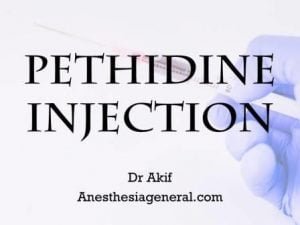Pethidine injection is a synthetic morphine like analgesic. this opioid medication has about one tenth as powerful compared to morphine.
This drug has sedative and tranquilizing effects also.
It may cause euphoria and sleepiness. Unlike morphine it tends to relax smooth muscles and thus relieves most types of pain associated with plain muscle spasm. But biliary colic is not relieved by pethidine.
Pethidine injection dose
The usual dose of pethidine in adults ranges from 75 to 100 mg (1.5 to 2 mg/kg). This drug can be given by the oral route or even parenterally. The action of this drug lasts for 2 to 3 h.
 Pethidine injection effects
Pethidine injection effects
Pethidine injection depresses respiration, both in rate and depth. this opioid medication raises the intracranial pressure. It can cause addiction.
This opioid drug has anticholinergic action and produces some atropine-like effects like dry mouth and dilated pupils. It has quinidine like action and it reduces cardiac irritability. Blood pressure is usually unaffected but hypotension may occur in some cases.
This drug has no effect of constipation on gastrointestinal tract that is seen more with morphine. Nausea and vomiting may occur.
It has no adverse effect on liver. It passes through placental barrier and may affect fetus. Urinary output and peristaltic movements of ureter are diminished. Histamine release may occur locally, but general effects are rare.
Pethidine injection side effects
Side effects of pethidine are
- sweating,
- tachycardia,
- hypotension,
- vertigo,
- limb tingling,
- nausea and
- vomiting.
Pethidine injection metabolism
Pethidine is well absorbed by all routes of administration. Following oral administration its peak concentration is usually observed between first and second hour and only about 50% of the drug escapes first-pass metabolism to enter the circulation. Metabolic degradation occurs to the extent of 80% within hepatic cells by enzyme systems.
About 5 to 10% of this medication is excreted without any change by the kidneys. The renal excretion may be increased by forced diuresis and by making the urine more alkaline.
Special care is needed when administered in extremes of ages, in respiratory and endocrinal cripples, in severe kidney and liver diseases and in patients with MAO inhibitors.

